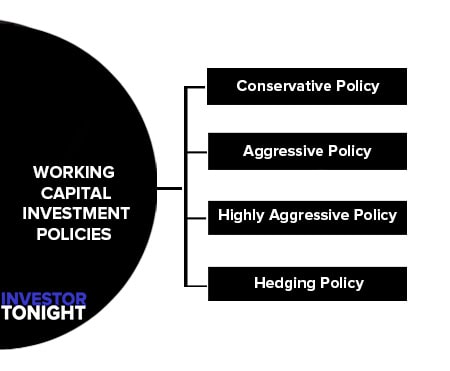Working capital financing policy basically deals with the sources and the amount of working capital that a company should maintain. A firm is not only concerned about the amount of current assets but also about the proportions of short-term and long-term sources for financing the current assets.
There are several working capital investment policies a firm may adopt after taking into account the variability of its cash inflows and outflows and the level of risk.
Table of Contents
Working Capital Investment Policies

Conservative Policy
As the name suggests, conservative policy tries to avoid the risk involved in financing of current assets. Here, relatively high proportions of long-term sources are to be used for financing current assets. The firm not only matches the current assets with current liabilities but also keeps some excess amount to meet any uncertainty.
This is the lowest risk working capital policy and fails to ensure optimum utilization of funds. Hence it cuts down the expected returns of the shareholders.
This policy is illustrated below. Line A denotes the fixed assets and Line B denotes the permanent working capital, which is financed through long-term sources. Certain portion of fluctuating current assets, which is shown by dashed Line C, is also financed by long-term sources. Under this policy some part of fluctuating current assets is financed through short-term sources.
Aggressive Policy
Aggressive working capital financing policy is a risky policy that requires maximum amount of investment in current assets. Fluctuating as well as permanent current assets under this policy will be financed through short-term debt. In this policy debt is collected on time and payments to the creditors are made as late as possible. This policy has been illustrated below.
According to this approach, long-term sources are used to finance the fixed assets, which are shown by Line A; but a portion of permanent current assets, shown by the dotted Line B, is also financed through long-term sources. The remaining part of permanent current assets, depicted by Line C, and the entire amount of fluctuating current assets, shown by the curved Line D, are financed by short-term debt.
Highly Aggressive Policy
This is a highly risky policy for financing the working capital. As per this policy, even some part of fixed assets is financed through short-term sources. Excessive reliance on short-term sources makes this policy highly risky. This policy has been illustrated below.
A major proportion of fixed assets as shown by dotted Line A are financed through long-term sources and the remaining part of the fixed assets are financed by short-term sources—shown by Line B. Short-term sources are also used for financing permanent current assets—Line C; as well as fluctuating current assets as shown by the curved Line D.
Hedging Policy
One of the policies by which a firm finances its working capital needs is the hedging policy, also known as matching policy. This policy works in an arrangement where the current assets of the business are used perfectly to match the current liabilities. As per this approach, fixed and permanent current assets are financed through long-term sources and fluctuating current assets are financed through short-term sources.
This policy is a medium risk proposition and requires a good amount of attention. For example, if a bank loan is due to be paid after six months, the company will ensure that sufficient amount of cash will be available to repay the loan on the date of maturity even though it may or may not currently have sufficient cash.
In case of a growth firm, the amount of fixed assets and permanent current asset go on increasing with the passage of time but the volume of fluctuating current assets change with the change in production level. In the following figure, Line A and Line B is upward slopped indicating that they go on increasing with the passage of time and as per hedging principle they are financed through long-term sources like equity and long-term debt. Fluctuating current assets, which are shown by the curved Line C, should be financed through short term sources.
Read More Articles
- What is Financial Management?
- What is Financial Statements?
- What is Financial Statement Analysis?
- What is Ratio Analysis?
- What is Funds Flow Statement?
- What is Cash Flow Statement?
- What is Working Capital?
- What is Cost of Capital?
- What is Capital Budgeting?
- What is Dividend Policy?
- What is Cash Management?
- What is Depository?
- What is Insurance?
- What is Financial System?
- International Financial Reporting Standards
- Stability of Dividends
- What is Factoring?
- Determinants of Working Capital
- Public Finance
- Public Expenditure
- What is Public Debt?
- Classification of Public Debt
- Federal Finance
- Effect of Public Debt
- Expenditure Cycle